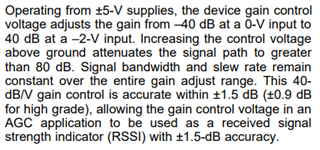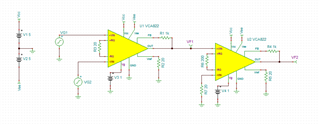Other Parts Discussed in Thread: VCA822, LMH6503, LMH6505, VCA821
Hi, I'm using VCA810. The deviations of positive and negative cycles of the input signal are high. For ex:
1. Gain = 55.4865 (with external resistor block and VCA810) Input : +- 20mV
Result : Positive cycle of the signal deviation : Expected voltage x 1.22
Negative cycle of the signal deviation : Expected voltage x 1.08
1. Gain = 5.5742 (with external resistor block and VCA810) Input : +- 20mV
Result : Positive cycle of the signal deviation : Expected voltage x 1.12
Negative cycle of the signal deviation : Expected voltage x 1.07
1. Gain = 110.2018 (with external resistor block and VCA810) Input : +- 20mV
Result : Positive cycle of the signal deviation : Expected voltage x 1.25
Negative cycle of the signal deviation : Expected voltage x 1.105
1. Gain = 167.5665 (with external resistor block and VCA810) Input : +- 20mV
Result : Positive cycle of the signal deviation : Expected voltage x 1.2
Negative cycle of the signal deviation : Expected voltage x 1.07
1. Gain = 14.0665 (with external resistor block and VCA810) Input : +- 20mV
Result : Positive cycle of the signal deviation : Expected voltage x 1.13
Negative cycle of the signal deviation : Expected voltage x 1.05
As you can see above, each signal deviates approximately 1.2 at positive cycle, 1.08 at negative cycle. Is there an explanation for this situation? Because fault error like fixed. Thanks for advance.





